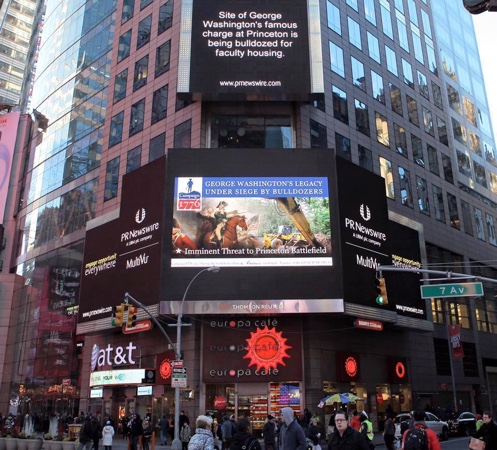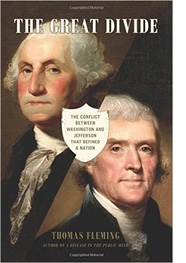Yes, that Was George Washington Leading a Charge in Times Square

In recent days, tourists and other strollers in Times Square must have felt they were hallucinating. On a huge illuminated billboard across the front of the AT&T building on the corner of 43rd Street, and Seventh Avenue, George Washington was leading a ferocious charge while American and British soldiers fought to the death around him. Above the painting was a message: GEORGE WASHINGTON’S LEGACY UNDER SIEGE FROM BULLDOZERS. Beneath it was an explanation: “Imminent Threat to Princeton Battlefield.”
 The startled
strollers who gazed up at this display were being invited into a
violent dispute that was raging seventy miles away, in Princeton, New
Jersey. The Institute for Advanced Study, which invites scholars from
around the world to join its faculty in exploring the frontiers of
knowledge in history, mathematics, natural sciences and social
science, was locked in a ferocious struggle with the Princeton
Battlefield Society – a group of concerned history lovers who
opposed the IAS’s determination to build faculty housing on a third
of the Princeton battlefield.
The startled
strollers who gazed up at this display were being invited into a
violent dispute that was raging seventy miles away, in Princeton, New
Jersey. The Institute for Advanced Study, which invites scholars from
around the world to join its faculty in exploring the frontiers of
knowledge in history, mathematics, natural sciences and social
science, was locked in a ferocious struggle with the Princeton
Battlefield Society – a group of concerned history lovers who
opposed the IAS’s determination to build faculty housing on a third
of the Princeton battlefield.
The IAS seems utterly indifferent to what had occurred on this portion of the battlefield. In my fifty year study of the American Revolution, I have come to regard it as the most important moment in our eight year struggle for liberty and equality. Having outwitted the main British army by marching on Princeton by night, Washington confronted two British regiments in a hasty line of battle behind a fence. On horseback, Washington led his men toward them. At thirty yards he roared: “Halt and fire!” Both sides blasted full volleys.
A cloud of gunsmoke enveloped the battlefield. One of Washington’s aides put his hat in front of his eyes, certain that the general was dead. As the smoke cleared, he gazed in astonishment at the big man, still in his saddle. With a ferocious shout, the Americans swarmed around the British flanks. The redcoats realized they were outnumbered 5-1. “A resolution was taken to retreat, i.e. run away as fast as we could,” recalled one junior officer,
Washington led the pursuit, which saw vaunted British regulars littering the road with muskets, canteens and knapsacks in a style too often displayed by Americans thus far in the contest. That fact alone, aside from the symbolic example of Washington’s courage, makes the Princeton Battlefield the most precious site in the long years of sacrifice and courage that marked so many encounters in our Revolution.
This is why the Princeton Battlefield Society has fought the Institute for Advanced Study for almost two years in the courts and in dozens of events to raise money for legal appeals. They have sought to encourage resistance to the IAS claim that comfortably housing their faculty was more important than this crucial memento of America’s founding. The PBS struggle inspired the Civil War Trust, which has won similar fights to preserve the battlefields of that war, to join them as an ally.
With their ample funds, the Trust paid for the painting of the battle which appeared on the screen of the AT&T building. It was their reaction to the news that the IAS had unleashed bulldozers on the disputed part of the battlefield.
Are there any Americans who can read this story and not join in this protest? I hope the IAS will soon learn how many people are outraged by their indifference to America’s history.